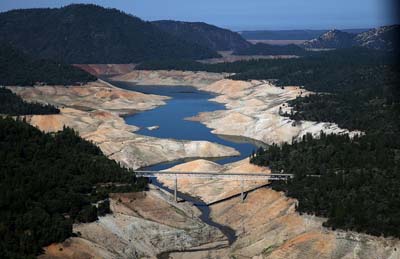From the New York Times 5/30/15 – Nicholas Kristoff
[dropcap]L[/dropcap]et’s start with a quiz…
Which consumes the most water?
A) a 10-minute shower.
B) a handful of 10 almonds.
C) a quarterpound hamburger patty.
D) a washing machine load.
The answer? By far, it’s the hamburger patty. The shower might use 25 gallons. The almonds take up almost a gallon each, or close to 10 gallons for the handful. The washing machine uses about 35 gallons per load. And that beef patty, around 450 gallons.

A section of Lake Oroville is seen nearly dry on August 19, 2014 in Oroville, California. As the severe drought in California continues for a third straight year, water levels in the State’s lakes and reservoirs are reaching historic lows. Lake Oroville is currently at 32 percent of its total 3,537,577 acre feet.
The drought in California hit home when I was backpacking with my daughter there recently on the Pacific Crest Trail, and the first eight creeks or springs we reached were all dry.
The crisis in California is a harbinger of water scarcity in much of the world. And while we associate extravagant water use with swimming pools and verdant lawns, the biggest consumer, by far, is agriculture. In California, 80 percent of water used by humans goes to farming and ranching.
That’s where that hamburger patty comes in
A mandarin orange consumes 14 gallons of water. A head of lettuce, 12 gallons. A bunch of grapes, 24 gallons. One single walnut, 2 gallons.
Animal products use even more water, mostly because of the need to raise grain or hay to feed the animals. Plant material converts quite inefficiently into animal protein.
So a single egg takes 53 gallons of water to produce. A pound of chicken, 468 gallons. A gallon of milk, 880 gallons. And a pound of beef, 1,800 gallons of water. (Of course, these figures are all approximate, and estimates differ. These are based on data from the Pacific Institute and National Geographic.)
You can also calculate your own water footprint at National Geographic’s website
Our industrial food system produces food almost miraculously cheaply. In 1930, whole dressed chicken retailed for $6.48 per pound in today’s currency, according to the National Chicken Council; in real terms, the price has fallen by more than three-quarters. And, boy, is the system good at producing cheap high-fructose corn syrup!
Yet industrial agriculture imposes other unsustainable costs:
• It overuses antibiotics, resulting in dangers to the public from antibiotic-resistant diseases. About four-fifths of antibiotics sold in the United States are for livestock and poultry — even as 23,000 people die annually in America from antibiotic resistant infections, according to the Centers for Disease Control and prevention.
• Farming overuses chemicals such as pesticides, some of them endocrine-disruptors that have been linked to possible cancer, obesity and reproductive disorders.
• Factory farming is often based on treating animals, particularly poultry, with ruthless cruelty.
To this indictment, we can add irrational subsidies and water engineering projects that have led to irrigation in areas where it doesn’t make sense. Today, California, despite the drought, is effectively exporting water (in the form of milk, beef, walnuts and produce).



